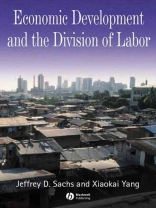This innovative new text from Jeffrey Sachs and Xiokai Yang introduces students to development economics from the perspectives of inframarginal analysis and marginal analysis. The book demonstrates how the new-found emphasis on inframarginal analysis has influenced a shift back to an interest in Classical Economics from Neoclassical Economics.
- Inframarginal Analysis vs. Marginal Analysis is presented as a consistent theoretical framework throughout.
- Shows how the relationship of Inframarginal Analysis to Marginal Analysis has influenced the shift back to an interest in Classical Economics from Neoclassical Economics with regard to economic development.
- Allows economists to reduce their overall reliance on marginal analysis, which may be less relevant to development economics than it is to the economics of development countries.
- Brings considerable analytic machinery to bear on important problems.
- A focus on institutions and transaction costs that is very relevant to development economics.
- Offers a thorough analysis of trade (CHs. 3 – 7) and macroeconomics (CHs. 16 – 19), both of which are not dealth with in depth by comparable textbooks.
Inhoudsopgave
Preface.
1. Introduction.
Part I: Geography and Microeconomic Mechanisms for Economic Development:.
2. Geography and Economic Development.
3. Driving Force I: Exogenous Comparative Advantage and Trading Efficiency.
4. Driving Force II: Endogenous Comparative Advantage and Trading Efficiency.
5. Driving Force III: Economies of Scale and Trading Efficiency.
6. Coexistence of Endogenous and Exogenous Comparative Advantages and Patterns of Development and Trade.
7. Structural Changes, Trade, and Economic Development.
Part II: The Institution of the Firm, Endogenous Transaction Costs, and Economic Development:.
8. Economic Development, the Institution of the Firm, and Entrepreneurship.
9. Endogenous Transaction Costs, Contract, and Economic Development.
10. Transaction Risk, Property Rights, Insurance, and Economic Development.
Part III: Urbanization and Industrialization:.
11. Urbanization, Dual Structure between Urban and Rural Areas, and Economic Development.
12. Industrialization, Structural Changes, Economic Development, and Division of Labor in Roundabout Production.
Part IV: Dynamic Mechanisms for Economic Development:.
13. Neoclassical Models of Economic Growth.
14. Economic Development Generated by Endogenous Evolution in Division of Labor.
15. Social Experiments and Evolution of Knowledge of Economic Development.
Part V: Macroeconomics of Development:.
16. Investment, Saving, and Economic Development.
17. Money, Division of Labor, and Economic Development.
18. Endogenous Business Cycles, Cyclical Unemployment, and Endogenous, Long-run Growth.
19. Economic Transition.
References.
Index.
Over de auteur
Xiaokai Yang is a Personal Chair Professor in the Department of Economics at Monash University and a Fellow of the Academy of Social Sciences in Australia. His research papers have appeared in The American Economic Review, Journal of Political Economy, Journal of Economics, and other journals. He is the author of Economics: New Classical versus Neoclassical Frameworks (Blackwell, 2000).












